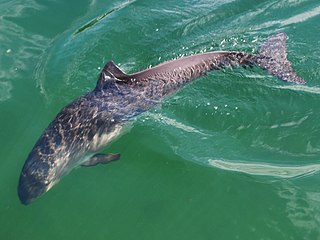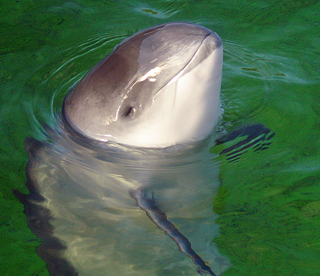 W
WPorpoises are a group of fully aquatic marine mammals, similar in appearance to a dolphin, all of which are classified under the family Phocoenidae, parvorder Odontoceti. They are, however, more closely related to narwhals and belugas than to the true dolphins. There are eight extant species of porpoise, all among the smallest of the toothed whales. Porpoises are distinguished from dolphins by their flattened, spade-shaped teeth distinct from the conical teeth of dolphins, and lack of a pronounced beak, although some dolphins also lack a pronounced beak. Porpoises, and other cetaceans, belong to the clade Cetartiodactyla with even-toed ungulates, and their closest living relatives are the hippopotamuses, having diverged from them about 40 million years ago.
 W
WDall's porpoise is a species of porpoise endemic to the North Pacific. It is the largest of porpoises and the only member of the genus Phocoenoides. The species is named after American naturalist W. H. Dall.
 W
WThe East Asian finless porpoise is a species of porpoise native to the East China Sea, Yellow Sea, and the seas around Japan. The Yangtze finless porpoise was formerly considered a subspecies, but is now thought to be a distinct species.
 W
WNeophocaena is a genus of porpoise native to the Indian and Pacific oceans, as well as the freshwater habitats of the Yangtze River basin in China. They are commonly known as finless porpoises. Genetic studies indicate that Neophocaena is the most basal living member of the porpoise family.
 W
WThe harbour porpoise is one of eight extant species of porpoise. It is one of the smallest species of cetacean. As its name implies, it stays close to coastal areas or river estuaries, and as such, is the most familiar porpoise to whale watchers. This porpoise often ventures up rivers, and has been seen hundreds of miles from the sea. The harbour porpoise may be polytypic, with geographically distinct populations representing distinct races: P. p. phocoena in the North Atlantic and West Africa, P. p. relicta in the Black Sea and Sea of Azov, an unnamed population in the northwestern Pacific and P. p. vomerina in the northeastern Pacific.
 W
WThe Indo-Pacific finless porpoise is one of eight porpoise species. The species ranges throughout most of the Indian Ocean, as well as the tropical and subtropical Pacific from Indonesia north to the Taiwan Strait. Overlapping with this species in the Taiwan Strait and replacing it northwards is the East Asian finless porpoise.
 W
WPhocoena is a genus of porpoises with four extant species:
 W
WDall's porpoise is a species of porpoise endemic to the North Pacific. It is the largest of porpoises and the only member of the genus Phocoenoides. The species is named after American naturalist W. H. Dall.
 W
W"Porpoise Song" is a song written by Gerry Goffin and Carole King and performed by the Monkees as the theme song for their 1968 film Head and its accompanying soundtrack album. The single version runs more than a minute longer than does the album version. The song also appears on several Monkees greatest-hits albums.
 W
WBurmeister's porpoise is a species of porpoise endemic to the coast of South America. It was first described by Hermann Burmeister, for whom the species is named, in 1865. Locally it is known as marsopa espinosa and chancho marino.
 W
WThe spectacled porpoise is a small to midsize porpoise indigenous to the Southern Ocean. It is one of the most poorly studied cetaceans, partly due to its remote range in the southern ocean. What little is known about this porpoise species has been gathered mainly from stranded individuals, and a few observations of living animals made at sea.
 W
WThe vaquita is a species of porpoise endemic to the northern end of the Gulf of California in Baja California, Mexico. Averaging 150 cm (4.9 ft) (females) or 140 cm (4.6 ft) (males) in length, it is the smallest of all living cetaceans. The species is currently on the brink of extinction, and currently listed as Critically Endangered by the IUCN Red List; the steep decline in abundance is primarily due to bycatch in gillnets from the illegal totoaba fishery.
 W
WThe Yangtze finless porpoise is a species of toothed whale in the family Phocoenidae. It is endemic to the Yangtze River in China, making it the country's only known freshwater cetacean following the possible extinction of the baiji. The Yangtze finless porpoise is considered critically endangered and it is estimated that only about 1,000 remain. This small toothed whale faces many of the same threats that caused the baiji dolphin to possibly become extinct. The Yangtze River has a high traffic rate of human activity causing population declines due to illegal fishing, pollution, vessel traffic, and dam construction. Due to the rapidly declining population of the species, the Chinese Government and conservation charities are working to help save it from extinction.